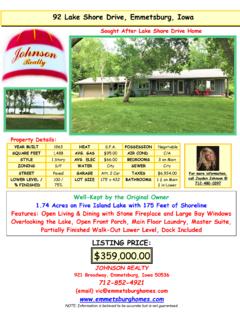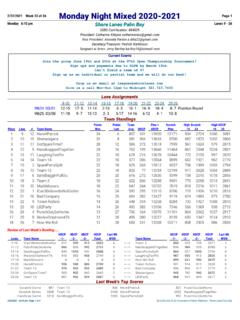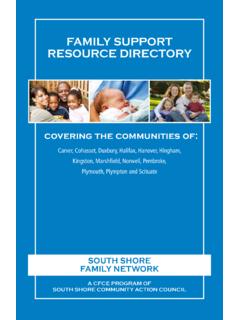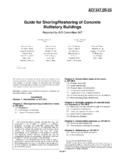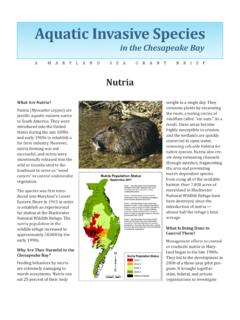Transcription of s e s s a l C e r u s o p x E e t e r c n o C - Nor Shore …
1 Determination of the minimum concrete performance properties is based upon identifying the following key requirements: Applicable Exposure Conditions The de-signer must assess the environmental conditions that the concrete will be exposed to during its service life. Direct input is also required from the Owner regarding possible future uses since they can significantly affect the exposure class selection Structural Requirements The designer must determine the minimum concrete properties re-quired to meet the applicable loading conditions Architectural Requirements The designer must consider the effects of selecting various archi-tectural finishes on concrete material properties.
2 Minimum Durability Requirements Based upon the designer s assessment of the exposure conditions, the CSA standard sets minimum concrete cases where these various factors result in differ-ing material properties, the designer must select the most stringent requirement as the minimum concrete performance Concrete Materials and Methods of Concrete Construction, Tables 1 4 outline the minimum durability SPECIFICATIONSC oncrete Exposure ClassesConcrete Exposure ClassesConcrete Exposure ClassesPhoto courtesy of OCAP hoto courtesy of RMCAOCSA TABLE 1 Definitions of C, F, N, A, and S exposure classes(See Clauses , , , , , and Tables 2 and 12.)
3 C-XL Structurally reinforced concrete exposed to chlorides or other severe environments with or without freezing and thawing conditions, with higher durability performance expectations than the C-1, A-1 or S-1 Structurally reinforced concrete exposed to chlorides with or without freezing and thawing conditions. Examples: bridge decks, parking decks and ramps, portions of marine structures located within the tidal and splash zones, concrete exposed to seawater spray, and salt water Non-structurally reinforced ( plain) concrete exposed to chlorides and freezing and thawing.
4 Examples: garage floors, porches, steps, pavements, sidewalks, curbs, and Continuously submerged concrete exposed to chlorides but not to freezing and thawing. Examples: underwater portions of marine Non-structurally reinforced concrete exposed to chlorides but not to freezing and thawing. Examples: underground parking slabs on Concrete exposed to freezing and thawing in a saturated condition but not to chlorides. Examples: pool decks, patios, tennis courts, freshwater pools, and freshwater control Concrete in an unsaturated condition exposed to freezing and thawing but not to chlorides.
5 Examples: exterior walls and Concrete not exposed to chlorides nor to freezing and thawing. Examples: footings and interior slabs, walls and Structurally reinforced concrete exposed to severe manure and/or silage gases, with or without freeze-thaw exposure. Concrete exposed to the vapour above municipal sewage or industrial effluent, where hydrogen sulphide gas may be generated. Examples: reinforced beams, slabs and columns over manure pits and silos, canals, pig slats, access holes, enclosed chambers, and pipes that are partially filled with Structurally reinforced concrete exposed to moderate to severe manure and/or silage gases and liquids, with or without freeze-thaw exposure.
6 Examples: reinforced walls in exterior manure tanks, silos and feed bunkers, exterior Structurally reinforced concrete exposed to moderate to severe manure and/or silage gases and liquids, with or without freeze-thaw exposure in a continuously submerged condition. Concrete continuously submerged in municipal or industrial effluents. Examples: interior gutter walls, beams, slabs and columns, sewage pipes that are continuously full ( , force mains), and submerged portions of sewage treatment Non-structurally-reinforced concrete exposed to moderate manure and/or silage gases and liquids, without freeze-thaw exposure.
7 Examples: interior slabs on Concrete subjected to very severe sulphate exposure (Tables 2 and 3).S-2 Concrete subjected to severe sulphate exposure (Tables 2 and 3).S-3 Concrete subjected to moderate sulphate exposure (Tables 2 and 3).Notes:(1) C classes pertain to chloride exposure.(2) F classes pertain to freezing and thawing exposure without chlorides.(3) N class is exposed to neither chlorides nor freezing and thawing.(4) A class pertains to agricultural, municipal or industrial projects exposed to human or animal wastes.(5) All classes of concrete, exposed to sulphates, shall comply with the minimum requirements of of S class noted in Tables 2 and TABLE 2 Requirements for C, F, N, R, S and A classes of exposure(See Clauses , , , , , , , , , and , and Table 1.)
8 Requirements for specifying concreteClass of exposure*Maximum water-to- cementing materials ratio Minimum specified compressive strength (MPa) and age (d) at test Air content category as per Table 4 Curing type (see Table 20)Chloride ion penetrability test requirements and age at test Normal within 56 d1 or 2 333< 1,000 coulombs within 56 dC-1 or at 28 d1 or 2 232< 1,500 coulombs within 56 dC-2 or at 28 d1222C-3 or at 28 d2122C-4** or at 28 at 28 at 28 d2 122N For structural designFor structural design at 56 at 56 at 56 d2122* See Table 1 for description of classes of exposure.
9 The minimum specified compressive strength may be adjusted to reflect proven relationships between strength and the water-to-cementing materials ratio. The water-to-cementing materials ratio shall not be exceeded for a given class of exposure. In accordance with ASTM C 1202. An age different from that indicated may be specified by the owner. Where calcium nitrite corrosion inhibitor is to be used, the same concrete mixture, but without calcium nitrite, shall be prequalified to meet the requirements for the permeability index in his Table. Use Category 1 for concrete exposed to freezing and thawing.
10 Use air content Category 2 for concrete not exposed to freezing and thawing.** For class of exposure C-4, the requirement for air entrainment should be waived when a steel trowelled finish is required. The addition of supplementary cementing materials may be used to provide reduced permeability in the long term, if that is required. Interior ice rink slabs and freezer slabs with a steel trowelled finish have been found to perform satisfactory without entrained air. To allow proper finishing and wear resistance, Type N concrete intended for use in an industrial concrete floor with a trowelled surface exposed to wear shall have a minimum cementing materials content of 265 Mixed Concrete Association of Ontario365 Brunel Road, Unit #3 Mississauga, Ontario L4Z 1Z5 Tel: Fax: Email.
